Investigating how to enhance english reading comprehension for the vietnamese tenthgraders at high schools in Gia Lai province
Although the National Foreign Languages 2020 Project was launched in 2008 to improve the
quality of ELT (English Language Teaching) at all levels of education in Vietnam, high school learners
of English have encountered many difficulties in mastering communication skills, especially reading
comprehension skill. The study examined and analyzed the result of applying speed reading strategies
to treat a group of 20 tenth graders at Asian Pacific College School in Gia Lai Province who was
involved in 15-week training course after having attended reading practice tests with another group.
This experimental approach also showed that the application of fast reading strategies such as skimming
and scanning did not only enhance learners' reading speed, confidence, and motivation but also forced
them to concentrate better on doing comprehension questions as well. Hence, these strategies should be
considered as a strategic choice to speed up reading comprehension skill for high school learners of
English, which will surely help widen their knowledge as the foundation for mastering other
communication skills in English
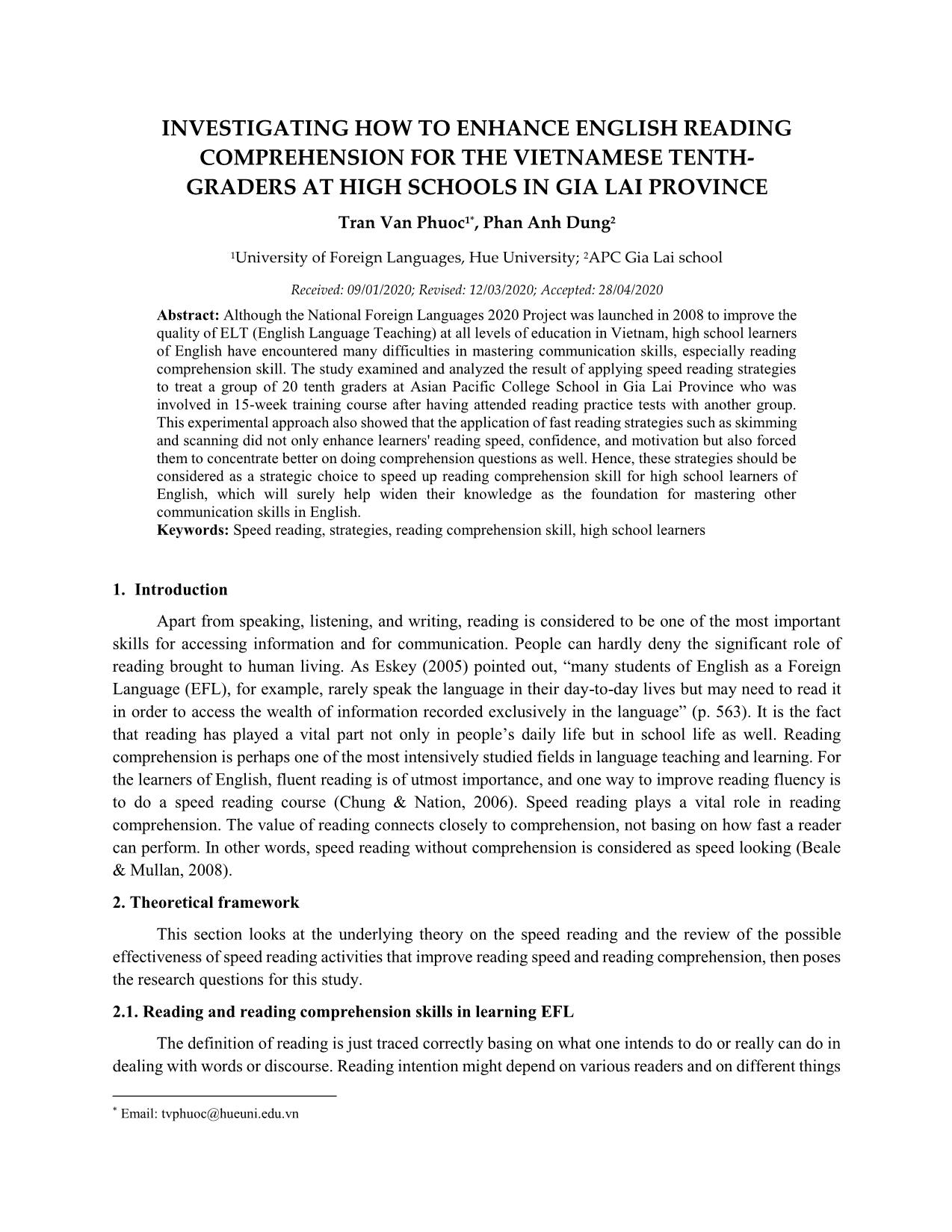
Trang 1
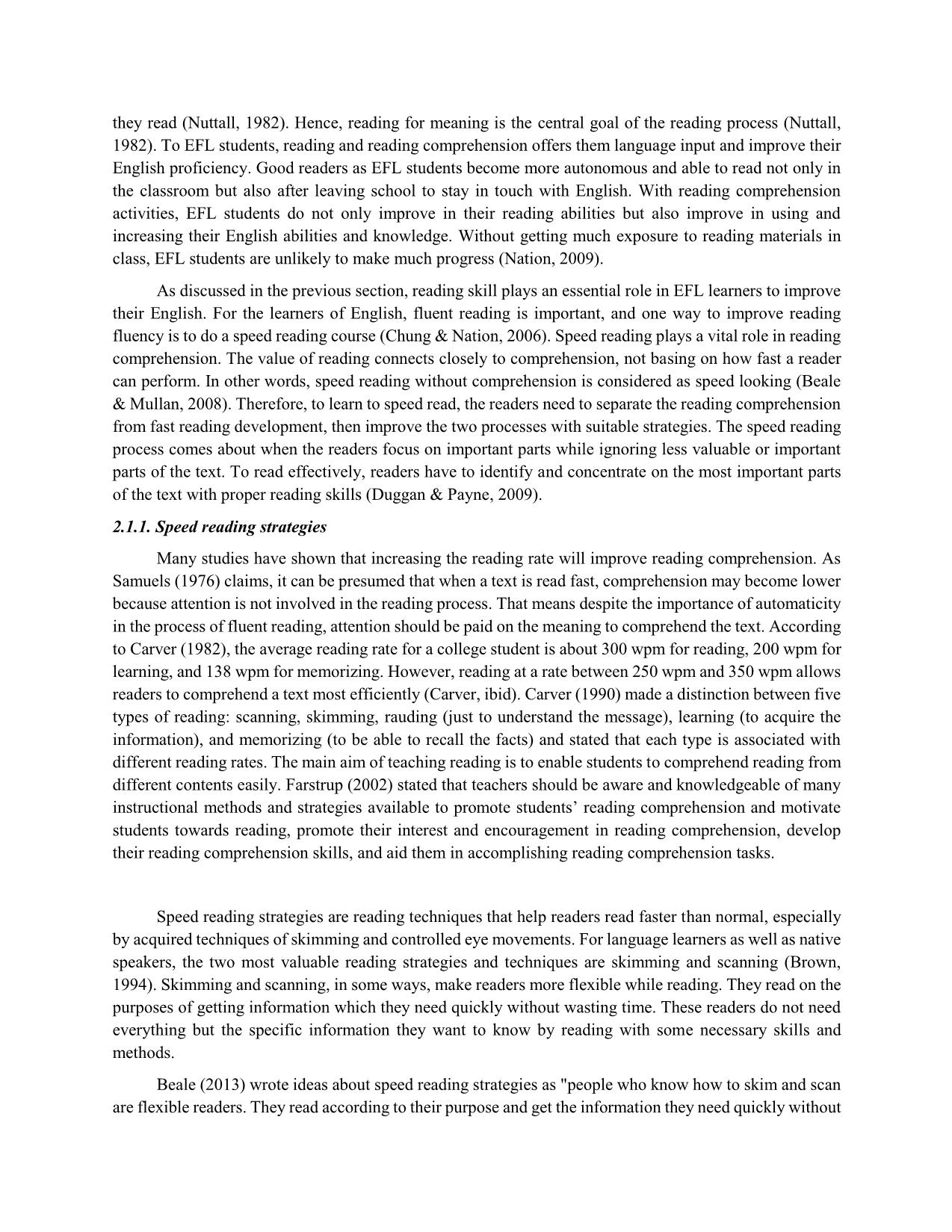
Trang 2
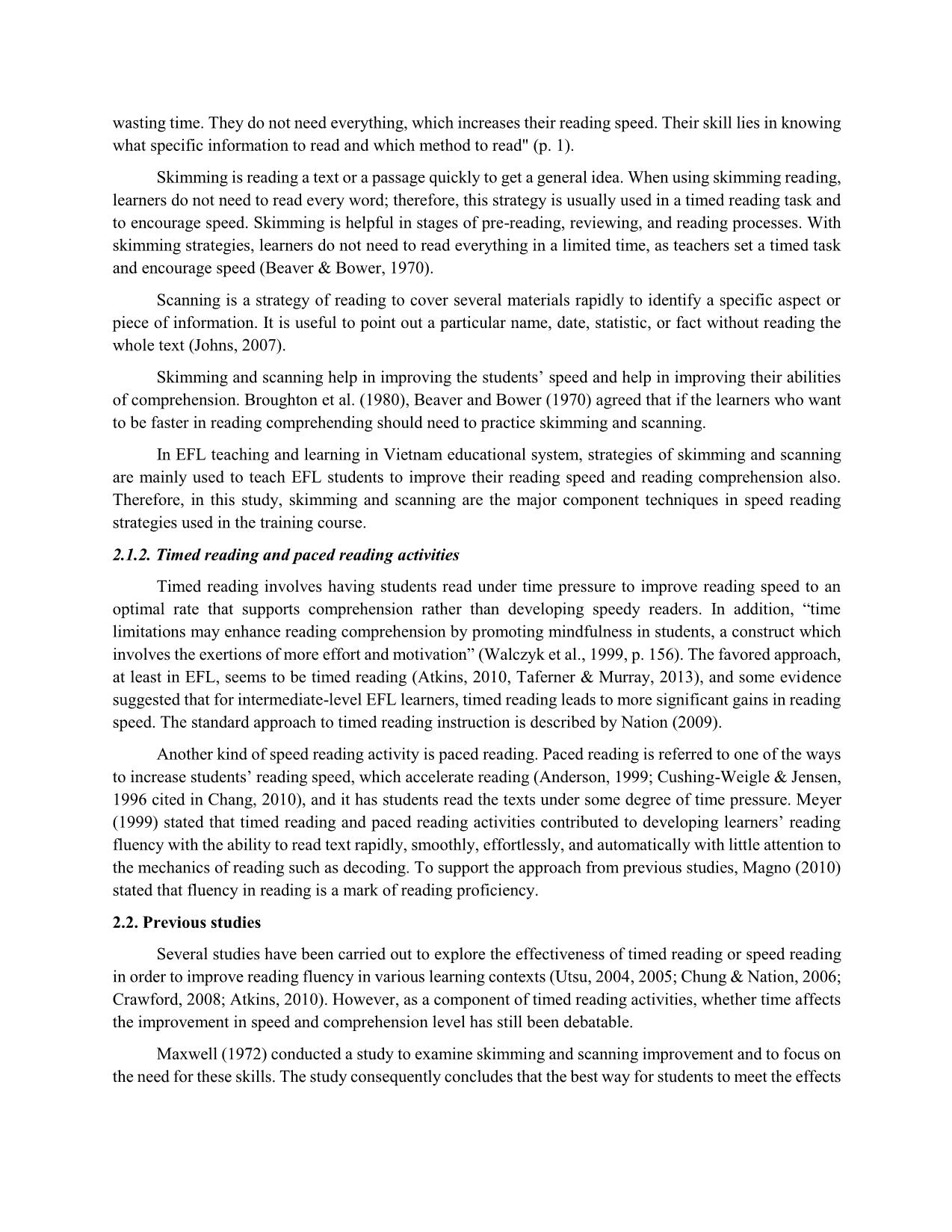
Trang 3
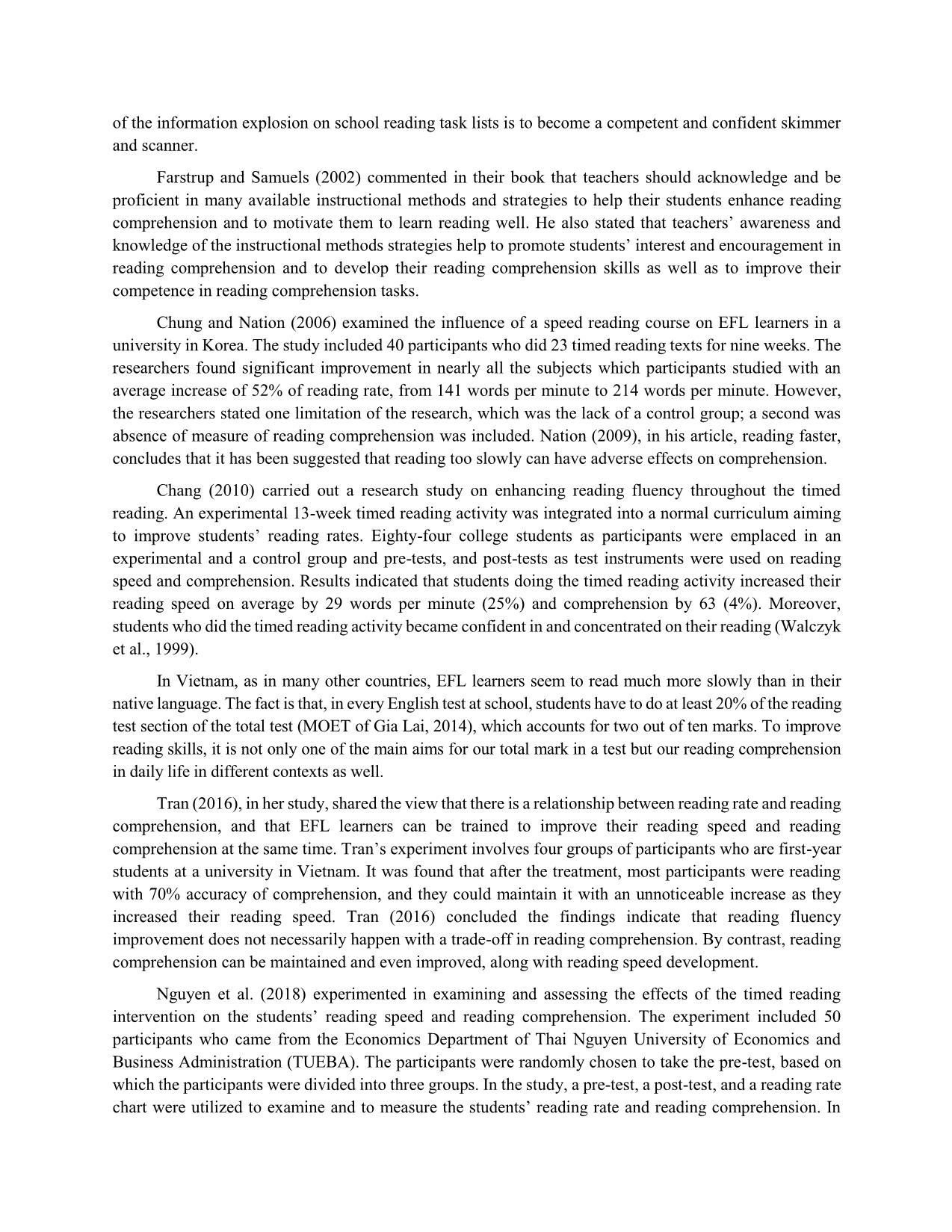
Trang 4
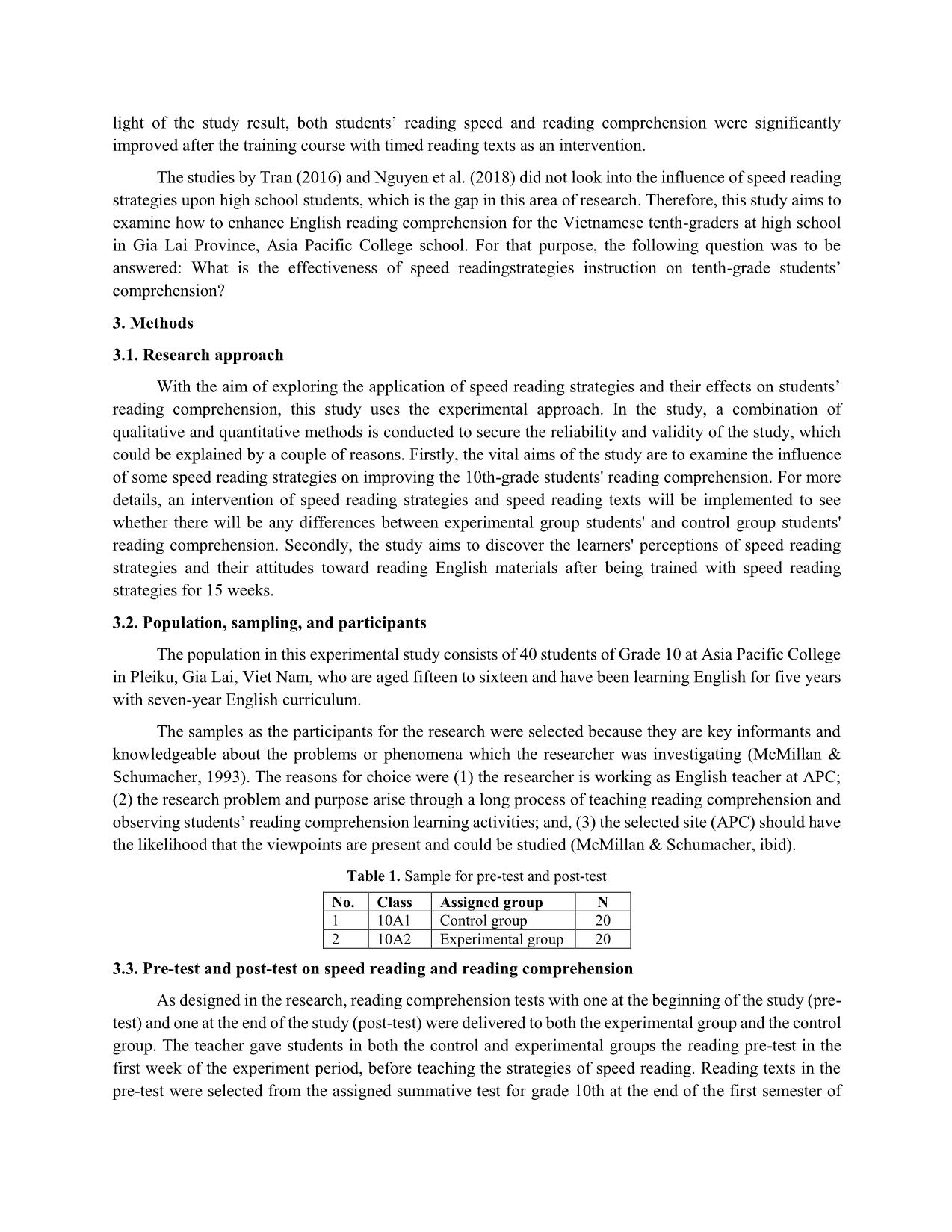
Trang 5
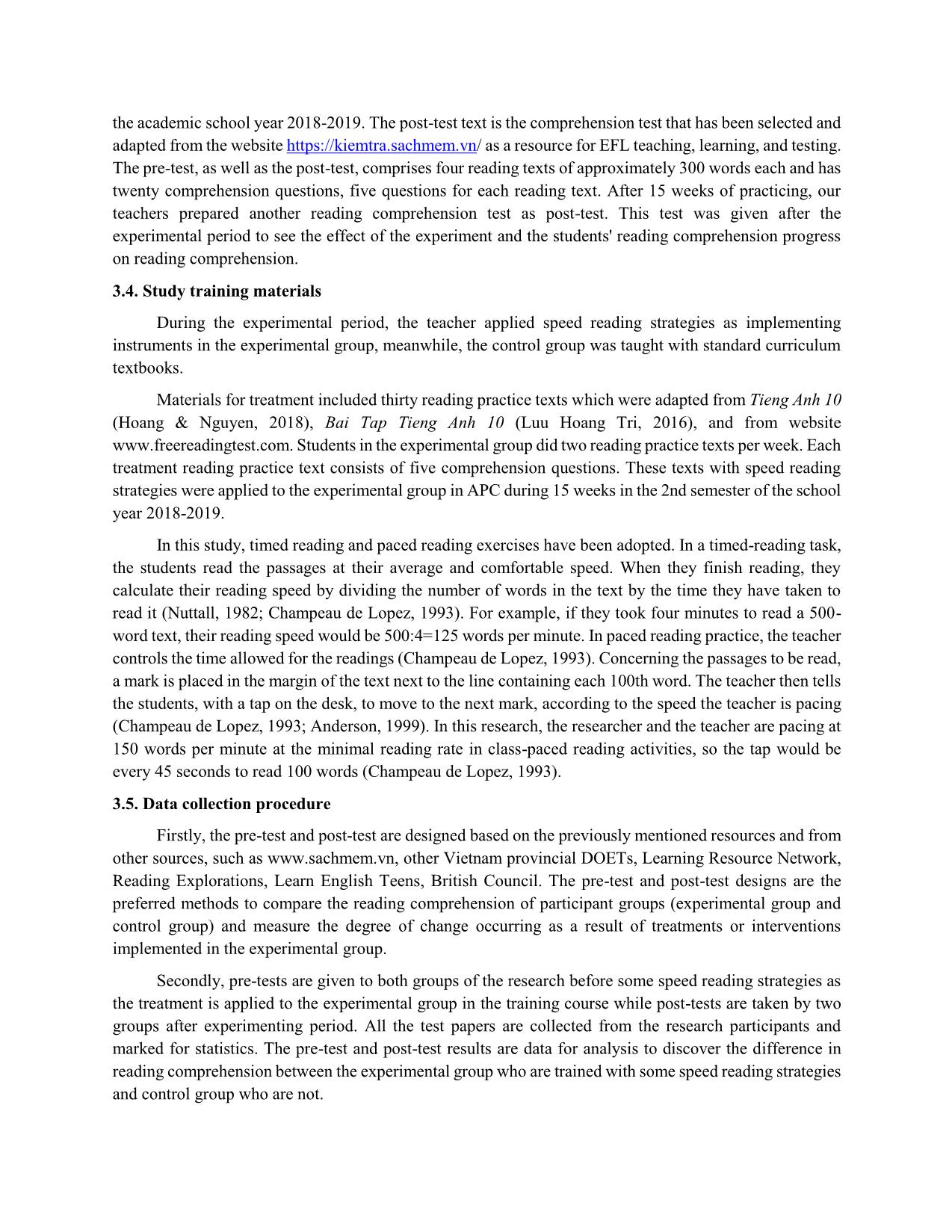
Trang 6
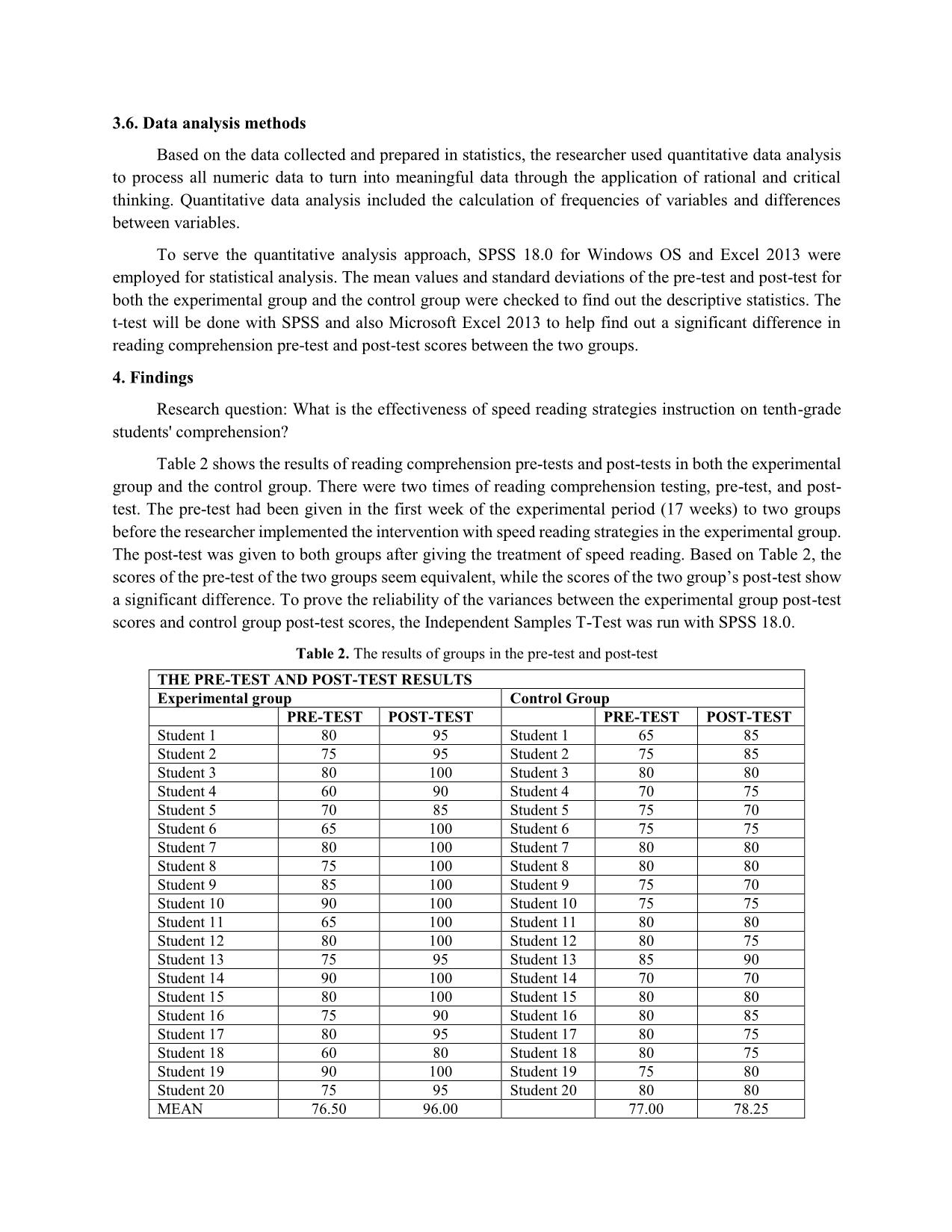
Trang 7
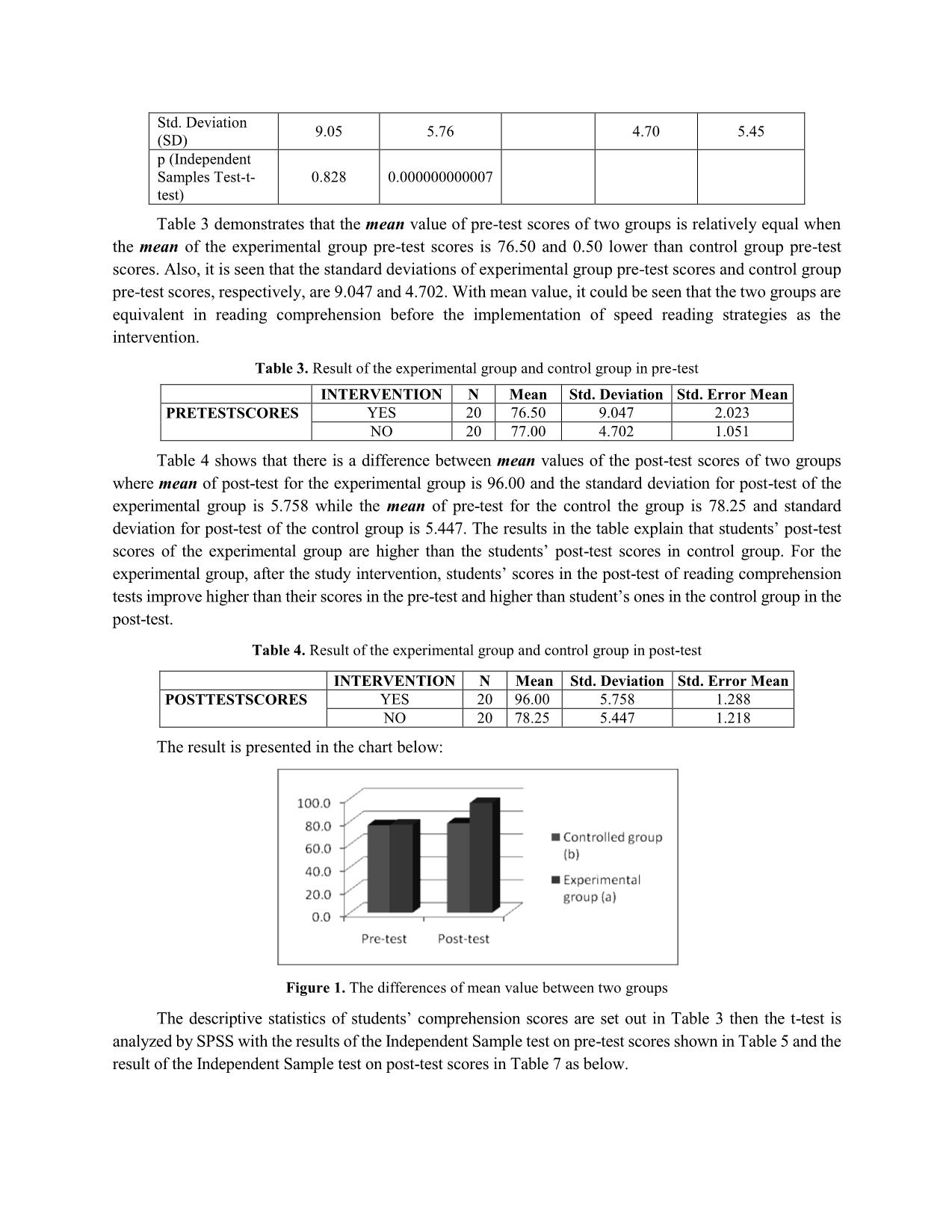
Trang 8
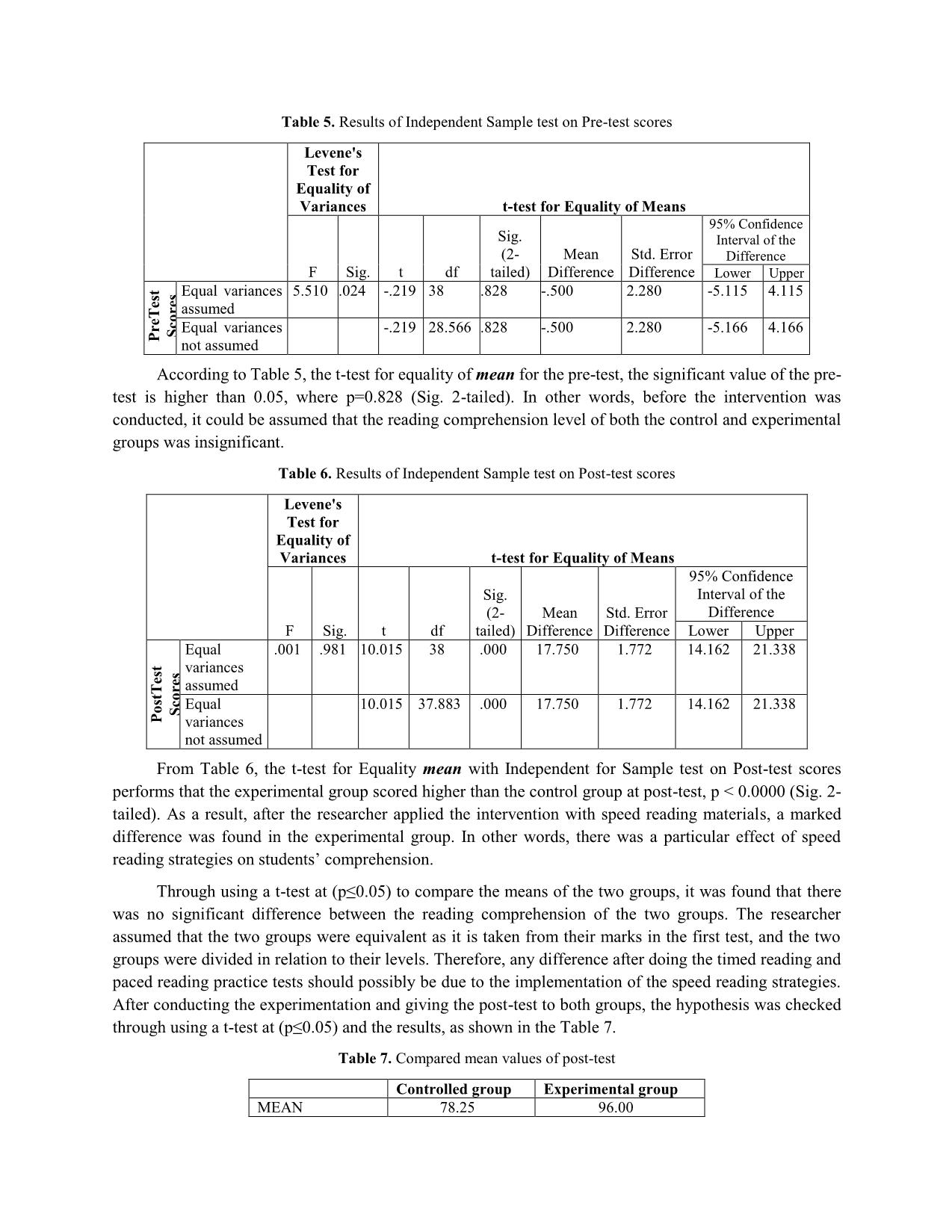
Trang 9
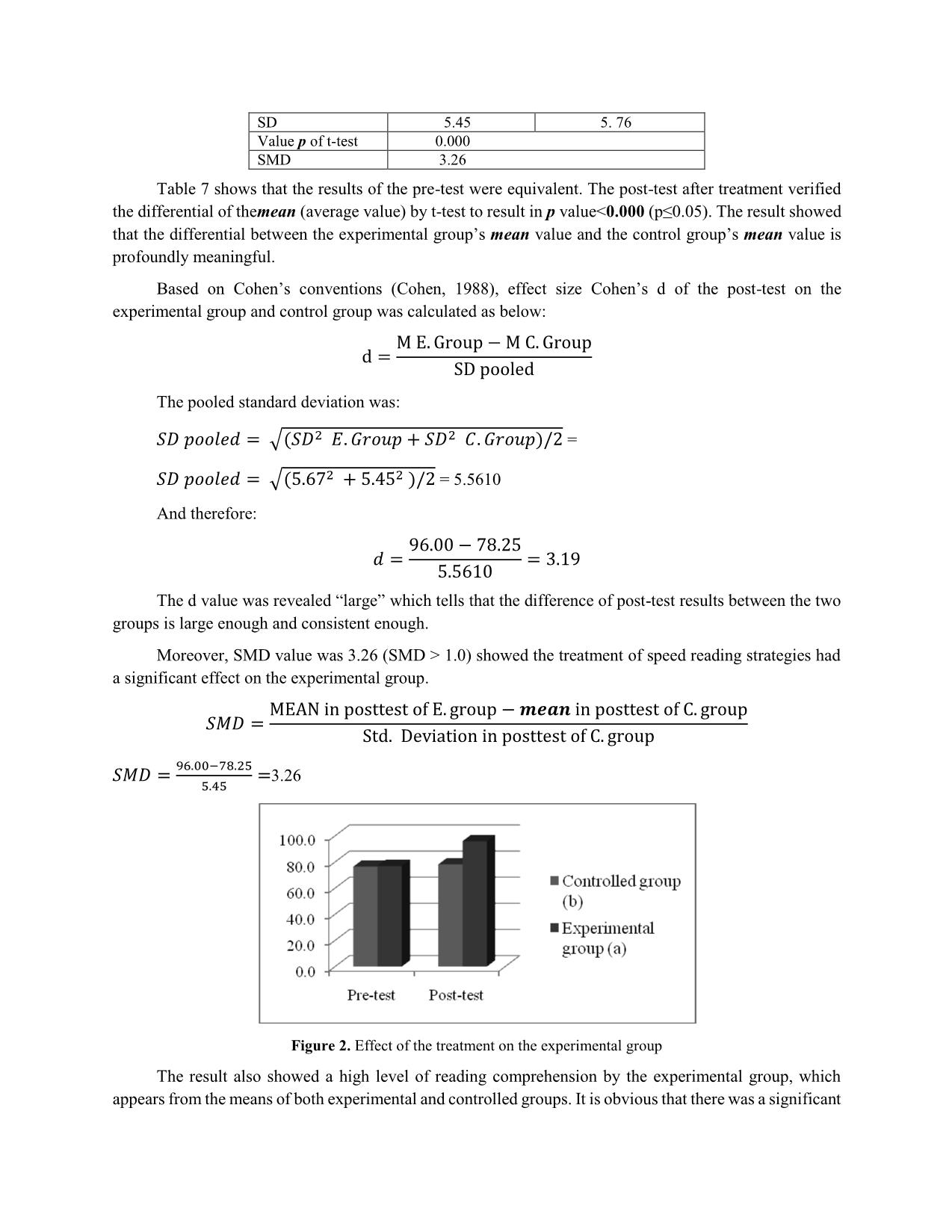
Trang 10
Tải về để xem bản đầy đủ
Tóm tắt nội dung tài liệu: Investigating how to enhance english reading comprehension for the vietnamese tenthgraders at high schools in Gia Lai province
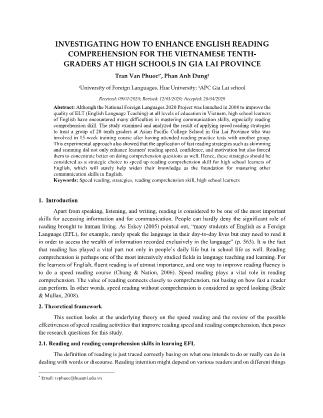
INVESTIGATING HOW TO ENHANCE ENGLISH READING COMPREHENSION FOR THE VIETNAMESE TENTH- GRADERS AT HIGH SCHOOLS IN GIA LAI PROVINCE Tran Van Phuoc1*, Phan Anh Dung2 1University of Foreign Languages, Hue University; 2APC Gia Lai school Received: 09/01/2020; Revised: 12/03/2020; Accepted: 28/04/2020 Abstract: Although the National Foreign Languages 2020 Project was launched in 2008 to improve the quality of ELT (English Language Teaching) at all levels of education in Vietnam, high school learners of English have encountered many difficulties in mastering communication skills, especially reading comprehension skill. The study examined and analyzed the result of applying speed reading strategies to treat a group of 20 tenth graders at Asian Pacific College School in Gia Lai Province who was involved in 15-week training course after having attended reading practice tests with another group. This experimental approach also showed that the application of fast reading strategies such as skimming and scanning did not only enhance learners' reading speed, confidence, and motivation but also forced them to concentrate better on doing comprehension questions as well. Hence, these strategies should be considered as a strategic choice to speed up reading comprehension skill for high school learners of English, which will surely help widen their knowledge as the foundation for mastering other communication skills in English. Keywords: Speed reading, strategies, reading comprehension skill, high school learners 1. Introduction Apart from speaking, listening, and writing, reading is considered to be one of the most important skills for accessing information and for communication. People can hardly deny the significant role of reading brought to human living. As Eskey (2005) pointed out, “many students of English as a Foreign Language (EFL), for example, rarely speak the language in their day-to-day lives but may need to read it in order to access the wealth of information recorded exclusively in the language” (p. 563). It is the fact that reading has played a vital part not only in people’s daily life but in school life as well. Reading comprehension is perhaps one of the most intensively studied fields in language teaching and learning. For the learners of English, fluent reading is of utmost importance, and one way to improve reading fluency is to do a speed reading course (Chung & Nation, 2006). Speed reading plays a vital role in reading comprehension. The value of reading connects closely to comprehension, not basing on how fast a reader can perform. In other words, speed reading without comprehension is considered as speed looking (Beale & Mullan, 2008). 2. Theoretical framework This section looks at the underlying theory on the speed reading and the review of the possible effectiveness of speed reading activities that improve reading speed and reading comprehension, then poses the research questions for this study. 2.1. Reading and reading comprehension skills in learning EFL The definition of reading is just traced correctly basing on what one intends to do or really can do in dealing with words or discourse. Reading intention might depend on various readers and on different things * Email: tvphuoc@hueuni.edu.vn they read (Nuttall, 1982). Hence, reading for meaning is the central goal of the reading process (Nuttall, 1982). To EFL students, reading and reading comprehension offers them language input and improve their English proficiency. Good readers as EFL students become more autonomous and able to read not only in the classroom but also after leaving school to stay in touch with English. With reading comprehension activities, EFL students do not only improve in their reading abilities but also improve in using and increasing their English abilities and knowledge. Without getting much exposure to reading materials in class, EFL students are unlikely to make much progress (Nation, 2009). As discussed in the previous section, reading skill plays an essential role in EFL learners to improve their English. For the learners of English, fluent reading is important, and one way to improve reading fluency is to do a speed reading course (Chung & Nation, 2006). Speed reading plays a vital role in reading comprehension. The value of reading connects closely to comprehension, not basing on how fast a reader can perform. In other words, speed reading without comprehension is considered as speed looking (Beale & Mullan, 2008). Therefore, to learn to speed read, the readers need to separate the reading comprehension from fast reading development, then improve the two processes with suitable strategies. The speed reading process comes about when the readers focus on important parts while ignoring less valuable or important parts of the text. To read effectively, readers have to identify and concentrate on the most important parts of the text with proper reading skills (Duggan & Payne, 2009). 2.1.1. Speed reading strategies Many studies have shown that increasing the reading rate will improve reading comprehension. As Samuels (1976) claims, it can be presumed that when a text is read fast, comprehension may become lower because attention is not involved in the reading process. That means despite the importance of automaticity in the process of fluent reading, attention should be paid on the meaning to comprehend the text. According to Carver (1982), the average reading rate for a college student is about 300 wpm for reading, 200 wpm for learning, and 138 wpm for memorizing. However, reading at a rate between 250 wpm and 350 wpm allows readers to comprehend a text most efficiently (Carver, ibid). Carver (1990) made a distinction between five types of reading: scanning, skimming, rauding (just to understand the message), learning (to acquire the information), and memorizing (to b ... on Cohen’s conventions (Cohen, 1988), effect size Cohen’s d of the post-test on the experimental group and control group was calculated as below: d = M E. Group − M C. Group SD pooled The pooled standard deviation was: 𝑆𝐷 𝑝𝑜𝑜𝑙𝑒𝑑 = √(𝑆𝐷2 𝐸. 𝐺𝑟𝑜𝑢𝑝 + 𝑆𝐷2 𝐶. 𝐺𝑟𝑜𝑢𝑝)/2 = 𝑆𝐷 𝑝𝑜𝑜𝑙𝑒𝑑 = √(5.672 + 5.452 )/2 = 5.5610 And therefore: 𝑑 = 96.00 − 78.25 5.5610 = 3.19 The d value was revealed “large” which tells that the difference of post-test results between the two groups is large enough and consistent enough. Moreover, SMD value was 3.26 (SMD > 1.0) showed the treatment of speed reading strategies had a significant effect on the experimental group. 𝑆𝑀𝐷 = MEAN in posttest of E. group − 𝒎𝒆𝒂𝒏 in posttest of C. group Std. Deviation in posttest of C. group 𝑆𝑀𝐷 = 96.00−78.25 5.45 =3.26 Figure 2. Effect of the treatment on the experimental group The result also showed a high level of reading comprehension by the experimental group, which appears from the means of both experimental and controlled groups. It is obvious that there was a significant difference between the means of both groups due to the implementation of speed reading strategies. Because of that, the Null hypothesis was rejected at (p≤0.05). The results also revealed that the students in the experimental group were better than the students in the controlled group. Apparently, the difference between the means was due to the implementation of speed reading strategies or timed reading activities. 5. Discussion and implications 5.1. Discussion The study examined the improvement of students' reading comprehension through speed reading strategies. Buzan (2003, p. 21) stated that reading rate and comprehension are two areas (among the top 20 areas) that commonly mentioned as requiring improvement. Accordingly, improving both reading rate and comprehension can be challenging. It is because improving the students' reading rate is not just about reading words faster than they read before. In general, the results showed that the experimental group improved in reading comprehension after 15 weeks doing 30 timed reading and paced reading practice tests. The results also indicated that although the intervention time is limited in 15 weeks, it can motivate students in reading and improve their reading confidence. More interestingly, there is a close relationship between reading speed and comprehension. For example, progress charts of individuals revealed that when their reading speed dropped, there was also a decline in their comprehension. In other words, it seems that reading one-word-at-a-time inhibits reading for understanding. Conversely, comprehension is generally higher when readers learn to read faster. First, the results of the study showed that there was a significant difference in reading comprehension by applying speed reading strategies. The result indicated that timed reading and paced reading practice tests were effective for the experimental group. When this study is compared with the previous one conducted by Chang (2010), regardless of the differences of scale, the learning context, there are some similarities between the two studies. The results of the present study revealed that including timed reading and paced reading activities in the regular reading texts of a standard school textbook; students could be better on comprehension skills to get the main idea as well as general information from reading texts after 15 weeks of training through 30 speed reading texts. Second, this study also looked at students' perceptions of speed reading strategies. Many students believed those speed reading strategies, as well as timed reading and paced reading activities, help them improve reading speed and reading comprehension at the same time. Besides, timed reading and paced reading also brought unexpected gain, such as language knowledge and feeling confident; moreover, they are reported to improve students' concentration, which seems to support research results of Walczyk et al. (1999). 5.2. Implications Some pedagogical implications also arise from the findings of solutions and suggestions already discussed. First, speed reading strategies had some positive effects on improving students’ reading speed and reading comprehension after one applied academic semester at APC Gia Lai. Speed reading strategies need to be applied in English classes more regularly and flexibly. That is, without changing textbook contents, teachers should add to teach more strategies in reading comprehension sections or change the methods of conducting teaching reading with speed reading strategies to make students more motivated and dynamic in their learning. Second, regarding the issue of applying speed reading strategies, teachers should deepen their knowledge and improve their skills by regular professional development activities related to selecting, training, and applying speed reading strategies in practical teaching implementation in EFL classes at high school. The success of the English class requires not only teachers’ effort but students’ as well. That is the reason why, together with the supports from teachers, students should pay attention to their learning process to be active learners. Due to the quite large size classes and limited time for teaching and learning in class, students should manage for self-studying and training of speed reading strategies to obtain productive habits of effective reading. Therefore, such autonomy and responsibility will contribute to good reading comprehension. 6. Conclusion The findings of the study highlight the influence of speed reading strategies in enhancing English reading comprehension for the Vietnamese tenth-graders at APC school in Gia Lai Province. These findings are expectedto extend the understanding of the speed reading strategies in teaching and learning English as a foreign language in Vietnamese contexts. The results of this study, to some extent, are not conclusive; however, they supported findings by Maxwell (1972), Farstrup & Samuels (2005), Chung & Nation (2006), Chang (2010), Tran (2016) and Nguyen et al. (2018). It was found that the speed reading strategies can be used to train EFL tenth-graders, and they can help them improve their reading comprehension. The experimental results indicate that participants who had not been trained with speed reading strategies appearednot to gain reading speed and reading comprehension. In contrast, those who had been trained in speed reading courses could increase their reading comprehension. The finding may be useful for teachers and the tenth-grade students when they encourage EFL learners in APC school to read with ease and comprehend more in learning English. This experimental research was conducted on a rather small scale with limited time and ability.Therefore, it is expected that further studies should be carried out to explore other factors that may affect EFL learners’ reading speed and reading comprehension, such ascognitive and psycholinguistic factors. Larger scale with more participants and facilities studies are also recommended so that the study results would be more conclusive and convincing. References Anderson, N.J. (1999). Improving reading speed: Activities for the classroom. English Teaching Forum, 37, 2-5. APC. (2019). Retrieved from Asia Pacific College Gia Lai: tuc-su-kien/nha-truong-va-xa-hoi/truong-quoc-te-chau-a-thai-binh-duong-gia-lai-apc-gia-lai-.html. Atkins, A. (2010). Timed reading: Increasing reading speed and fluency (A.M. Stoke, Ed.). JALT 2009 Coference Proceedings (pp. 662-271). Tokyo: JALT. Beale, A.M. (2013). Anne arundal community college. Retrieved from: www.aacc.ed:www.aacc.ed /tutoring/file/skimming.pdf. Beale, A.M., & Mullan, P. (2008). The complete idiot's guide to speed reading. New York, Toronto, Victoria, Auckland, London: The Penguin Group. Beaver, T., & Bower, T. (1970). How to read without listening. In M. Lester (Ed), Readings in Applied Transformational Grammar (pp. 474-479). New York: Holt, Rinehart and Winston. Broughton, G., Brumfit, C., Flavell, R., Hill, P., & Pincas, A. (1980). Teaching English as a Foreign Language (2nd edition). New York, USA: Routledge. Brown, H.D. (1994). Teaching by principles: An interactive approach to language pedagogy. Upper Saddle River: Prentice Hall Regents. Buzan, T. (2003). The speed reading book. London: BBC Book Pub. Carver, R. (1982). Optimal rate of reading prose. Reading Research Quarterly, 18, 56–58 Champeau de Lopez, C. (1993). Developing reading speed. English Teaching Forum, 31(2), 50-51. Chang, A.C.S. (2010). The effect of a timed reading activity on EFL learners: Speed, comprehension, and perceptions. Reading in a Foreign Language, 22(2), 284-303. Chung, M., & Nation, P. (2006). The effect of a speed reading course. English Teaching, 61(4), 181-204. Cohen, J. (1988). Statistical power analysis for the behavioral sciences (2nd edition). New Jersey, United States of America: Lawrence Erlbaum Associates, Publishers. Crawford, M.J. (2008). Increasing reading rate with timed reading. The Language Teacher, 32(2), 307. Cushing-Weigle, S., & Jensen, L. (1996). Reading rate improvement in university ESL classes. CATESOL Journal, 9, 55-71. DOET, G.L. (2014). Document 1559/SGDĐT-GDTrH, dated 14th October, 2014 on testing and assessment of English language for lower and upper secondary students since the school year 2014-2015. Gia Lai: Gia Lai DOET. Duggan, G.B., & Payne, J.S. (2009). Text skimming: The process and effectiveness of foraging through text under time pressure. Journal of experimental psychology Applied, 15(3), 228-242. Eskey, D.E. (2005). Reading in a second language. In E. Hinkel (Ed.), Handbook of research in second language teaching and learning (pp. 563-579). Mahwah: Lawrence Erlbaum. Farstrup, A.E., & Samuels, S.J. (2002). What research has to say about reading instruction (3rd edition). Newyork: International Reading Association. Free reading speed test (1996-2018). Retrieved from: readingtest.com/. Hoàng, V.V., & Nguyễn, T.C. (2018). Tiếng Anh 10. Hà Nội: Nxb Giáo dục Việt Nam. Hoàng, V.V., & Nguyễn, T.C. (2018). Tiếng Anh 9. (P.X. Thanh Ed.). Hồ Chí Minh: Nxb Giáo dục Việt Nam. Johns, A. (2007). Retrieved from: EzineArticles: Speed-Reading-Techniques&id=630070. Lưu, H.T. (2016). Bài tập tiếng Anh lớp 10. Hà Nội: Đại học Quốc gia Hà Nội. Magno, C. (2010). The effect of scaffolding on children’s reading speed, reading anxiety, and reading proficiency. TESOL Journal, 3, 92-98. Maxwell, M.J. (1972). Skimming and scanning improvement: The needs, assumptions and knowledge base. Journal of Reading Behavior, 5(1), 47-59. McMillan, J.H., & Schumacher, S. (1993). Research in education (3rd edition). New York: Harper Collins College Publisher. Meyer, M.S. (1999). Repeated reading to enhance fluency: Old approaches and new directions. Annals of Dyslexia, 49, 283-306. MOET-5333/BGDÐT-GDTrH (2014). Triển khai kiểm tra đánh giá theo định hướng phát triển năng lực môn tiếng Anh cấp trung học từ năm học 2014-2015. Hà Nội: Bộ Giáo dục và Đào tạo. Nation, P. (2009). Reading faster. International Journal of Engkish Studies, 9(2). Retrieved from: https://revistas.um.es/ijes/article/view/90791. Nguyen, V.T., Leng, T.T., & Ta, T.M. (2018). Impact analysis of timed reading intervention on students' reading fluencey and comprehension. IJARIIE, 4(2). Retrieved from: https://www.semanticscholar. org/paper/IMPACT-ANALYSIS-OF-TIMED-READING-INTERVENTION-ON-Thinh-Trang /86c548e9 1d0bc07f378296d2be13f4f9928c2875. Nuttall, C. (1982). Teaching reading skills in a foreign language. London: Heinmann Educational Books. Samuels, J.S. (1976). Automatic decoding and reading comprehension. Language Arts, 53(3), 323-325. Retrieved on March 30, 2019 from: https://www.jstor.org/stable/41404155. Taferner, R.H., & Murray, A. (2013). Influence of text length on reading fluency of intermediate EFL students. In N. Sonda & A. Krause (Eds.), JALT2012 Conference Proceedings. Tokyo: JALT. Tran, T.N.Y. (2016). EFL reading speed and reading comprehension. IOSR Journal of Humanity and Social Science (IOSR)-JHSS, 21(10), 01-10. Utsu, M. (2004). Timed readings no riyou to sono kouka (Timed readings and their effects on students). Bulletin of Yonezawa Women’s College of Yamagata Prefecture, 39, 31-37. Utsu, M. (2005). Timed readings no riyou to sono kouka 2 (Timed Readings and their effects on students (Part II)). Bulletin of Yonezawa Women’s College of Yamagata Prefecture, 40, 27-34. Walczyk, J.J., Kelly, K.E., Meche, S.D., & Braud, H. (1999). Time limitations enhance reading comprehension. Contemporary Educational Psychology, 24, 156-165. NGHIÊN CỨU PHƯƠNG THỨC TĂNG CƯỜNG ĐỌC HIỂU TIẾNG ANH CHO HỌC SINH VIỆT NAM LỚP 10 TRƯỜNG TRUNG HỌC PHỔ THÔNG Ở TỈNH GIA LAI Tóm tắt: Đề án Ngoại ngữ Quốc gia 2020 được tiến hành từ 2008 nhưng học sinh tiếng Anh vẫn gặp khó khăn khi sử dụng các kỹ năng giao tiếp nhất là kỹ năng đọc hiểu. Bài trình bày phân tích kết quả vận dụng các kỹ thuật đọc tốc độ trong khóa học 15 tuần rèn luyện nhóm 20 học sinh lớp 10 trường APC tại tỉnh Gia Lai sau khi họ tham gia kiểm tra đọc với 20 bạn khác. Thực nghiệm này chứng minh vận dụng các kỹ thuật đọc nhanh, đọc lướt, đọc sâu vừa tăng cường tốc độ đọc hiểu, sự tự tin; đồng thời, vừa bắt học sinh tập trung hơn vào câu hỏi đọc hiểu. Như vậy, các kỹ thuật này có thể là lựa chọn chiến lược tăng tốc độ đọc hiểu và giúp học sinh mở rộng kiến thức làm nền tảng cho những kỹ năng giao tiếp tiếng Anh khác. Từ khóa: Đọc tốc độ, kỹ thuật, kỹ năng đọc hiểu, tăng cường, học sinh phổ thông trung học
File đính kèm:
 investigating_how_to_enhance_english_reading_comprehension_f.pdf
investigating_how_to_enhance_english_reading_comprehension_f.pdf

